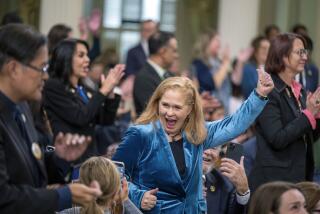Capitol Journal: California’s special elections are a waste of time and taxpayer money
Reporting from Sacramento — Want to save tax money? Have more dollars for schools or police? Then stop holding special elections hardly any voters care about.
Unlike many states, California wastes public funds by calling special elections to fill vacant seats in the Legislature.
Few people show up. Local taxpayers are out anywhere from a few hundred thousand dollars to well over a million. But the governor could do it for free and much more quickly.
Rules could be imposed to limit any gubernatorial game-playing. And legislative jitters about giving a governor more power could be eased by providing lawmakers a role in selecting the replacement.
This isn’t a new concept. California’s governor long has been able to fill vacancies in the U.S. Senate, other statewide offices and county boards of supervisors. In replacing statewide officials, the Legislature can reject the governor’s nomination.
The U.S. Constitution, however, requires a special election to fill a vacancy in the House of Representatives.
Three textbook cases of why special elections should be scrapped were on display last week in Los Angeles County.
Elections were held to temporarily replace two former assemblymen — Raul Bocanegra (D-Pacoima) and Matt Dababneh (D-Woodland Hills) — who resigned after being accused of sexual harassment. One former assemblyman, Sebastian Ridley-Thomas (D-Los Angeles), quit for health reasons.
Voter turnouts were pathetic, and that has become commonplace for special elections. When all ballots are tallied, they’ll probably represent fewer than 10% of registered voters.
“I went to vote at 9:30 a.m. and was only the second person to vote,” former legislative staffer Leah Cartabruno emailed me. “Good grief. It opened at 7 a.m.”
She voted in the 45th Assembly District, where Democrat Jesse Gabriel, an Encino attorney, finished first. The runner-up was the contest’s sole Republican, Justin Clark, a 19-year-old freshman at Cal State Northridge who works in an ice cream shop. There were five other Democrats on the ballot splitting the party vote.
Because Gabriel fell far short of the majority needed to win the seat outright, he’ll face Clark in a runoff on June 5, the date of the regular statewide election. Gabriel is a safe bet. Democratic voters outnumber Republicans in the district by 49% to 22%.
In the San Fernando Valley’s 39th Assembly District, with a field of five Democrats and one Republican, science instructor Luz Maria Rivas finished far ahead of the GOP candidate, plumbing and electrical contractor Ricardo Benitez. But the Democrat didn’t reach a majority. So these two candidates will compete in June. This district is lopsidedly Democratic, 53% to 15%.
In west Los Angeles’ 54th Assembly District, community college Trustee Sydney Kamlager won her seat in a landslide and will take office immediately.
But many voters will be confused in June. These special elections are only to decide who fills out the rest of the current Assembly terms, which end in December. There’ll also be the regular contests in June and November — featuring the same candidates — to elect Assembly members for the next two years.
All this is a head-shaker — convoluted and costly.
In the last 10 years, I count 32 special primary and general elections to fill vacant legislative seats. In 2014, a legislative consultant calculated there had been 136 special elections since 1989 for the Legislature and U.S. House. The average cost, the analyst said, was $1 million. And local governments pay.
Former state Senate leader Darrell Steinberg, who’s now the Sacramento mayor, introduced legislation four years ago to scrap special elections for legislative seats and let the governor fill them, with conditions.
Coverage of California politics »
At the time, legislators were quitting to run for another office, such as Congress, or slinking to the “dark side” to lobby for some high-paying special interest.
The governor would have been required to choose a replacement from the same party as the departing legislator. The affected house could have rejected the selection.
And a new state senator would have had to run for the seat at the next regular election, even if it was during the middle of a term. That’s the way it works with U.S. Senate replacements.
But Steinberg’s proposal met a chilly reception. Republicans were opposed. Democrats were leery. Lacking the required two-thirds majority needed for Senate floor passage, Steinberg pulled the measure.
In truth, he didn’t try very hard.
“I had a lot of priorities that year,” Steinberg recalled last week. “I didn’t put all my capital into passing that bill.
“The problem was that Democrats and Republicans each look at it through their own political lens. Republicans didn’t want to give power to a Democratic governor. Democrats’ concerns were a little more nuanced.”
Not really. Democrats didn’t want to give more power to a governor either, even a fellow party member.
“He might pick someone more loyal to him than them,” Steinberg said.
So we’re stuck with a money-wasting system that leaves some districts unrepresented in Sacramento for months.
Half the states are more sensible. Many trust their governor to fill the seats. Some allow local boards or political parties to make the appointments. Ohio lets the Legislature do it.
Almost anything would be better than our system that the voters pay for but ignore.
Follow @LATimesSkelton on Twitter
More to Read
Get the L.A. Times Politics newsletter
Deeply reported insights into legislation, politics and policy from Sacramento, Washington and beyond. In your inbox three times per week.
You may occasionally receive promotional content from the Los Angeles Times.











